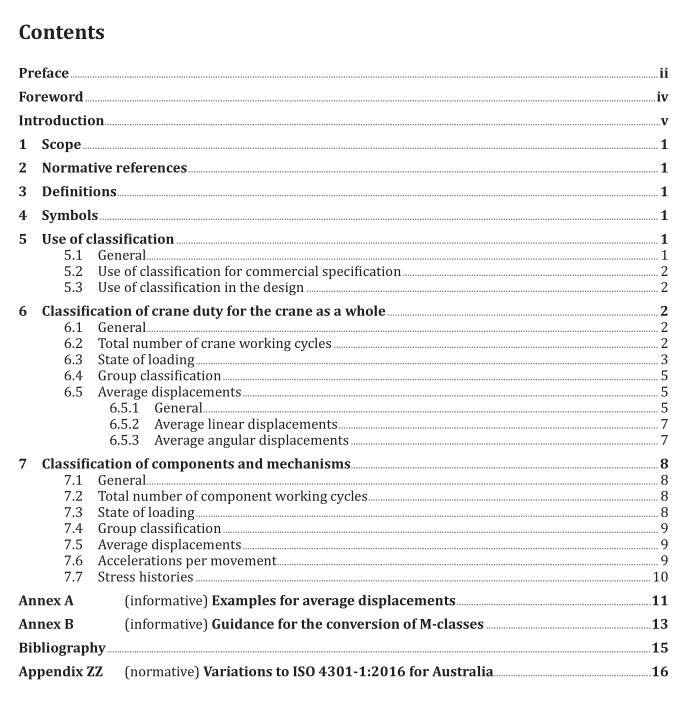AS 5246.1 pdf download – Cranes — Classification Part 1: General (ISO 4301-1:2016, MOD)

AS 5246.1 pdf download – Cranes — Classification Part 1: General (ISO 4301-1:2016, MOD)
Determination of an appropriate life requires consideration of economic, technical and environmental factors, and should have regard to the influence of obsolescence.
5.2 Use of classification for commercial specification The classification is applied by the purchaser and the manufacturer of a crane and/or load lifting attachments, between which agreement is necessary on the duty of the crane. The classification thus agreed is intended for contractual and technical reference purposes. It is also used to specify the service conditions of cranes, load lifting attachments, or components which are designed for serial manufacture and allows such items to be selected in accordance with their intended use. The specified classification shall be documented in the crane manuals.
5.3 Use of classification in the design The second purpose of classification is to provide a basis for the designer to build up his analysis of the design and to verify that the crane or component is capable of achieving the intended life under the specified service conditions of the particular application. As a person skilled in crane technology, the designer takes the specified service conditions, either provided by the purchaser or predetermined by the manufacturer (as is the case in the design of serial equipment), and incorporates them into the assumptions on which his analysis is based, having regard to all other factors which influence the proportioning of components. Crane operation gives rise to stress or load histories in crane structures and components (e.g. wire ropes, slewing bearings, or wheels and rails). These histories may be classified for the particular component. The method of determining this classification is set out in the appropriate standards, e.g. for structures in ISO 20332.
6 Classification of crane duty for the crane as a whole
6.1 General Crane duties are determined by the following parameters:
a) the total number of working cycles during the design life;
b) the relative frequencies of loads to be handled (load spectrum, state of loading);
c) the average displacements. When the classified ranges of parameters are used, the design shall be based on the maximum values of the parameters within the specified classes. Use of an intermediate value for a parameter is permissible, but in that case this design value shall be determined and indicated instead of the class.
6.2 Total number of crane working cycles For the purpose of classification, a crane working cycle is a sequence of movements which commences when the crane is ready to hoist the load and ends when the crane is ready to hoist the next load within the same task. A task, r, can be characterized by a specific combination of crane configuration and sequence of intended movements. In certain specific tasks for which cranes are used, for example, bulk unloading by grab, the number of cycles can readily be derived from a knowledge of the total number of working hours and the number of operating cycles per hour. In other cases, for example, mobile cranes, the number is less easy to determine because the crane is used in a variety of duties and it becomes necessary to estimate suitable









